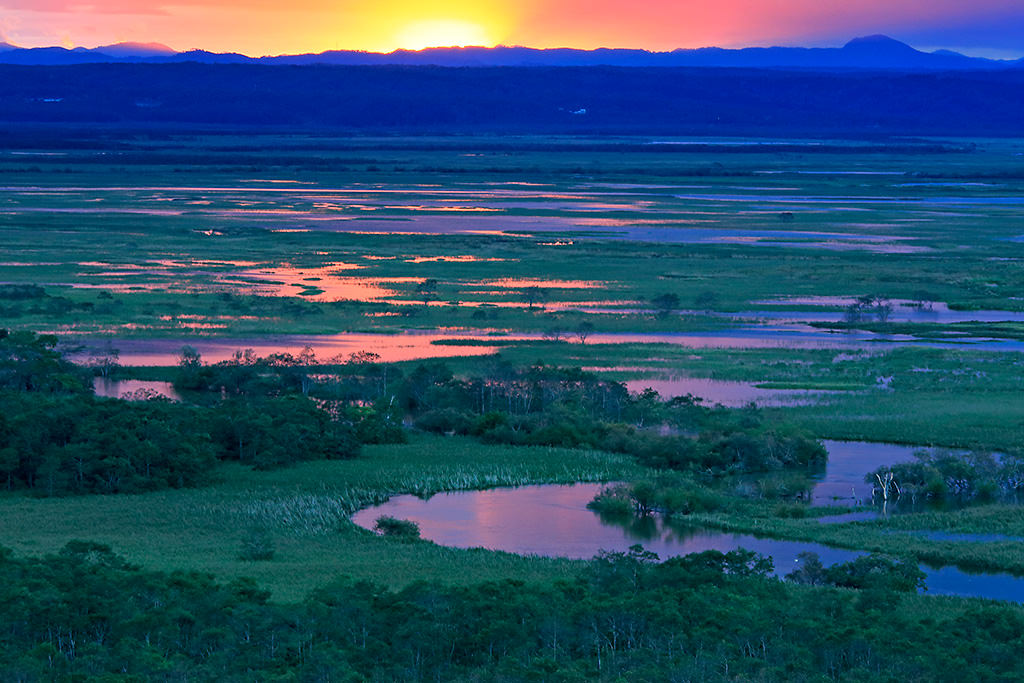Decisions in Landscape Photography: High Angle or Low Angle?
To shoot from a high angle or a low one? If you’ve found yourself stuck between the two options when shooting landscapes, you certainly aren’t the first. Whichever angle you choose influences your own personal shooting style. Here, we shall look at two photographers with different ideas on this topic, and learn about their shooting techniques. (Reported by: Toshiki Nakanishi, Masami Goto)

Low angle: Looking up with perspective exaggeration

EOS 5D Mark IV/ EF16-35mm f/4L IS USM/ FL: 23mm/ Aperture-priority AE (f/11, 1/5 sec, EV+1.3)/ ISO 200/ WB: Daylight
Photo by Toshiki Nakanishi
Toshiki Nakanishi says:
“When I step into a forest and look up through wide-angle lenses, I get to see a world that is totally different from what I would see with the naked eye and this makes me happy. When I take pictures looking up, I use a wide angle lens and shoot at as wide an angle as I can possibly get while still maintaining balance in the image. This way, I can make use of the lens’ perspective exaggeration effect to get the surroundings to look as vast as possible. You can create really bold shots with a low angle, but don’t forget to fine-tune your positioning to ensure that superfluous flaws don’t end up too obvious. For instance, make sure that the branches and leaves are spaced apart in a balanced way.”
Tip: When composing with a wide-angle, pay attention to the corners of the image

Failed shot
EOS 5D Mark IV/ EF16-35mm f/4L IS USM/ FL: 20mm/ Aperture-priority AE (f/11, 1/5 sec, EV+1.3)/ ISO 200/ WB: Daylight
Photo by Toshiki Nakanishi
This shot was taken with my usual style—distortion using the wide-angle range of a wide-angle lens to bring out a sense of space and expanse. However, due to either bad positioning or too wide an angle, the maple leaves look too far away from each other, and the photo seems to lack something as a result. It would have been better if I had paid attention to the four corners of the frame and positioned the leaves accordingly.
Check out the following for some wide-angle composition tips:
Exploring Wide Angle Lenses Part 2: Composition Techniques for Wide-Angle Lenses
High angle: Moderate the amount of sky to showcase the landscape’s unique features

EOS 5D Mark III/ EF70-200mm f/4L IS USM/ FL: 150mm/ Aperture-priority AE (f/10, 1/10 sec, EV-0.7)/ ISO 800/ WB: Auto
Photo by Masami Goto
Masami Goto says:
“When photographing vast landscapes from high ground, such as from an observation deck, most people will compose the image such that the sky takes up a large proportion of the frame. While this can indeed give a photo a majestic feel, it could also potentially weaken the impact of your original subject of interest—the landscape itself.
If this happens, instead of including a large expanse of sky in your composition, it might be better to shoot from a slightly high angle. Observe the natural scenery in front of you when you look down. If you get a good grasp of what makes it unique and special, you can convey its majesty even if you don’t put the entire scene in front of you (including the sky) into the frame. In fact, you will probably be able to obtain a more impactful shot of the landscape itself.”
Tip: Shooting at eye-level and including the sky in the frame diverts attention from the main point of interest

EOS 5D Mark III/ EF70-200mm f/4L IS USM/ FL: 116mm/ Aperture-priority AE (f/10, 1/10 sec, EV±0)/ ISO 800/ WB: Auto
Photo by Masami Goto
It is very tempting to feature the sky in your composition, especially at dawn or dusk where there are many transitions. This is what happened in the above photo, where I shot at eye level to include both the sky and the marsh in the frame. However, leaving most of the sky out of your composition, keeping the marsh as the point of focus and composing your photo to provide a birds’s-eye view of it helps to bring more depth to this scene of a marshland steeped in the rich colours of dusk.
For more on camera angles, read:
Camera FAQ #7: What is the Difference between Camera Position (Level) and Camera Angle?
Receive the latest updates on photography news, tips and tricks by signing up with us!
About the Author
A monthly magazine that believes that enjoyment of photography will increase the more one learns about camera functions. It delivers news on the latest cameras and features and regularly introduces various photography techniques.
Published by Impress Corporation
Born in Hokkaido in 1955, Goto started taking photos of the Daisetsuzan mountains in 1978 alongside commercial photography assignments. In 1984, he began travelling all around Hokkaido as a freelance photographer, documenting and photographing its natural landscapes. He currently photographs landscapes all over Japan, with a focus on the Hokkaido and Tohoku regions.
Born in 1971 in Osaka. After learning photography on his own, Nakanishi moved the base for his photography activities to the town of Biei located in Kamikawa-gun of Hokkaido. While capturing landscapes that focus on light, he also produces works that bring out the figurative beauty of nature. Head of PHOTO OFFICE atelier nipek.




































